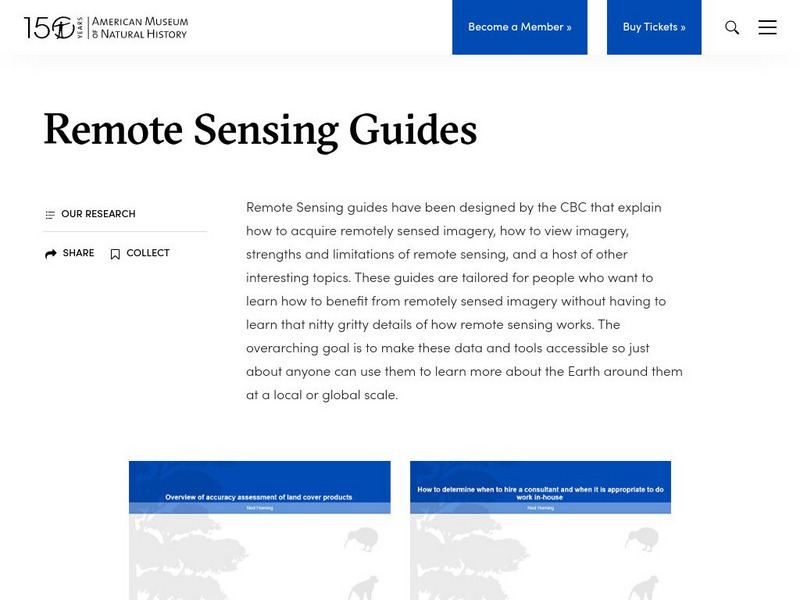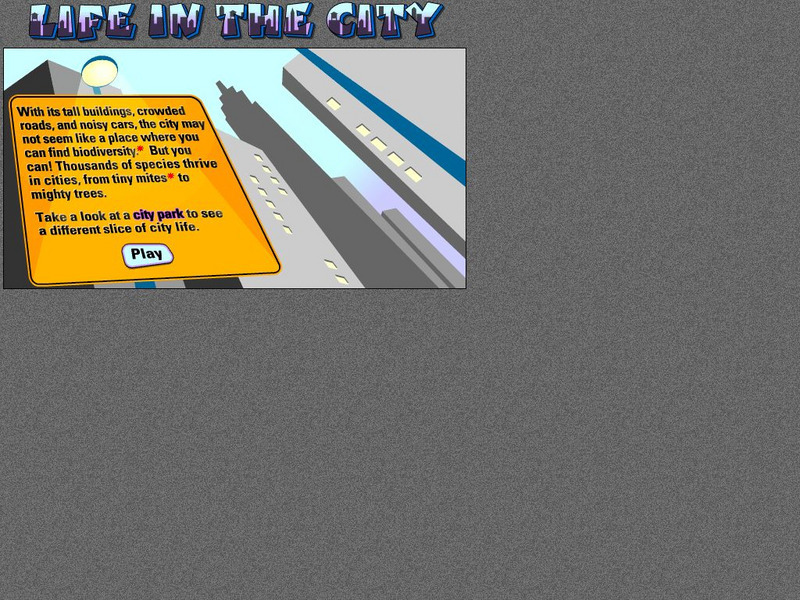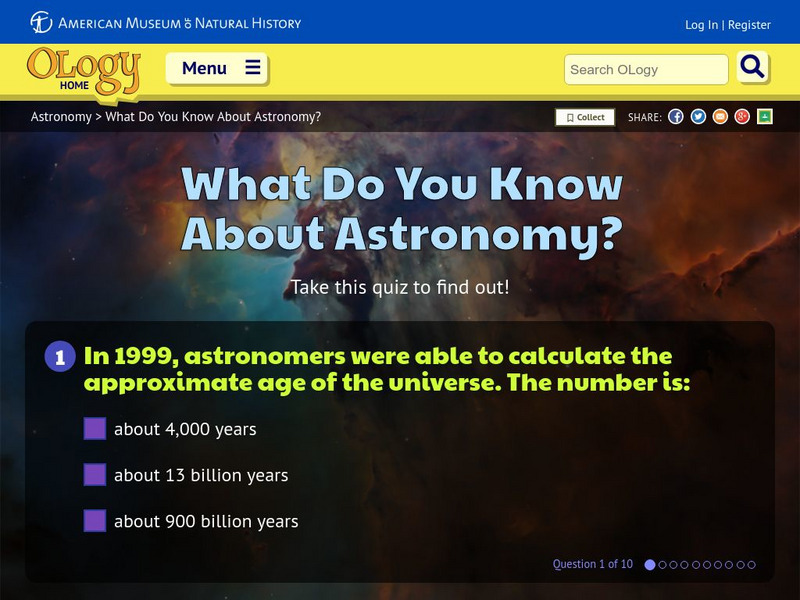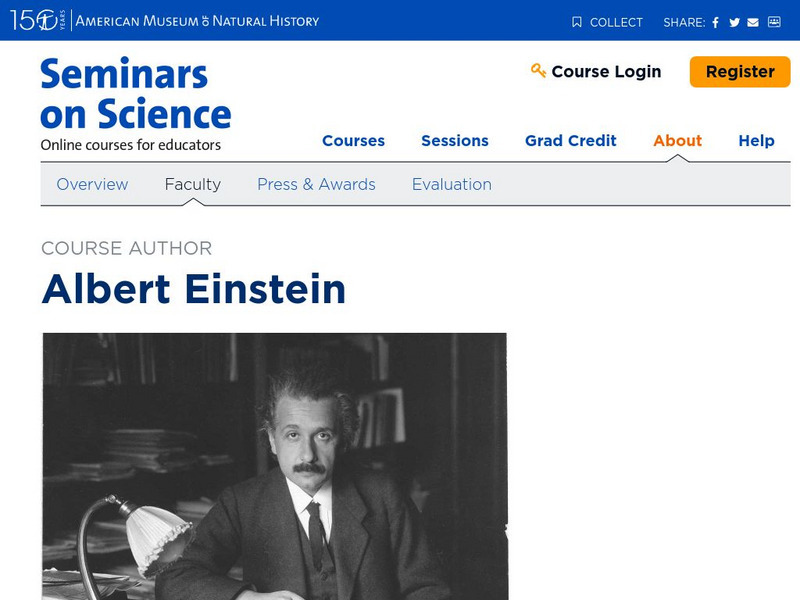American Museum of Natural History
American Museum of Natural History: Biodiversity Informatics: Remote Sensing
Guides and interactive tools to understand how remote sensing works. It includes links to several articles on various aspects of remote sensing.
American Museum of Natural History
American Museum of Natural History: Milstein Hall of Ocean Life
Tour the museum's famed exhibition hall dedicated to ocean life at this online recreation. Find videos, maps, species specimens, and images that let you experience many of the museum's resources on ocean life right from your desktop.
American Museum of Natural History
American Museum of Natural History: Dinosaurs: Bambiraptor and Birds
A 14-year-old boy found the fossils of a brand new species of dinosaur--the Bambiraptor. Find out the fun facts about what scientists have discovered about the Bambiraptor and how closely it was related to birds with this resource.
American Museum of Natural History
American Museum of Natural History: Picturing the Museum
Archive of historical photographs of the museum's dioramas and exhibits from the early twentieth century offers a glimpse into the work of exhibition designers from eras past.
American Museum of Natural History
American Museum of Natural History: Jade O Logy Card
Investigate some facts about jade by reading this interactive Ology card then answering some questions.
American Museum of Natural History
American Museum of Natural History: O Logy: Stuff to Do: Finding Fossils
Guidelines for investigating fossils in the field include specimen-finding strategies, dos and don'ts, examples of the kinds of fossils you may see, and other helpful information, such as how to record your observations and finds in a...
American Museum of Natural History
American Museum of Natural History: O Logy: The Amazing Mundo
Introduction, in comic strip format, to a selection of minerals and rocks that are used to make everyday objects, such as glass, aluminum foil, coins, and computer chips.
American Museum of Natural History
American Museum of Natural History: O Logy: Stuff to Do: Edible Earth
Take a look at the layers that make up our Earth: inner core, outer core, mantle, and crust. Then have fun making a model of the Earth's interior that you can eat up.
American Museum of Natural History
American Museum of Natural History: O Logy: Life in the City
Biodiversity can be found in many places, including city parks. At this OLogy learning game site, players use a magnifying glass to find organisms that live there and also learn something about how each organism relates to others nearby.
American Museum of Natural History
American Museum of Natural History: O Logy: What's the Big Idea? Biodiversity
Find information about diversity among genes, species, and ecosystems that helps answer questions about the importance of biodiversity and how we can save species from extinction.
American Museum of Natural History
American Museum of Natural History: O Logy: What's the Big Idea? Genetics
Find an overview of genetics--the science of genes--in a click-through series of short perspectives on the topic.
American Museum of Natural History
American Museum of Natural History: O Logy: Stuff to Do: Mint Your Own Coin
The information on coins tells us a lot about the national identity of the country where it was made. Learn about the language and symbolic content of coins by creating one of your own that communicates something about your personal...
American Museum of Natural History
American Museum of Natural History: O Logy: What Do You Know? Astronomy
Take this ten-question self-scoring quiz to test your knowledge of astronomy facts: age of the universe, why stars and planets are spheres, where other life might exist in the outer space, the Milky Way, and more.
American Museum of Natural History
American Museum of Natural History: O Logy: What's the Big Idea? Water
Illustrated article that explains why all living things need water.
American Museum of Natural History
American Museum of Natural History: O Logy: Beyond T. Rex
Launch this OLogy link to find a dinosaur cladogram, an illustration that organizes dinosaurs into groups based on the unique characteristics they share, like a three-toed foot.
American Museum of Natural History
American Museum of Natural History: O Logy: What's the Big Idea? Astronomy
An introduction to key concepts about the science of astronomy. With interactive flash cards that open in new windows to help you learn more.
American Museum of Natural History
American Museum of Natural History: O Logy: If Rocks Could Talk: Obsidian
A simple explanation of how obsidian rock is formed.
American Museum of Natural History
American Museum of Natural History: O Logy: If Rocks Could Talk: Granite
A simple explanation of how granite rock is formed.
American Museum of Natural History
American Museum of Natural History: O Logy: If Rocks Could Talk: Limestone
A simple explanation of how limestone rock is formed.
American Museum of Natural History
American Museum of Natural History: O Logy: If Rocks Could Talk: Sandstone
A simple explanation of how sandstone rock is formed.
American Museum of Natural History
American Museum of Natural History: Profile: Dr. Charles Liu
A biography of Dr. Charles Liu, an astrophysicist at the American Museum of Natural History focused on his drive to become an astrophysicist.
American Museum of Natural History
American Museum of Natural History: Ology: Moving Mammals
Students explore the different ways mammals move by observing them walk, hop, gallop, swim and swing in animations. Facts about habitat and structure are also included in these animations.
American Museum of Natural History
American Museum of Natural History: Profile: Albert Einstein
Read about the life and work of Albert Einstein, including details from his childhood and what he said about life just before he died.
American Museum of Natural History
American Museum of Natural History: Ology: Cosmic Cookies
Roll your mouse over the planets in our solar system to read a vignette about each. Then, link to the recipe for directions to create miniature planet cookies that look like the real thing.





















